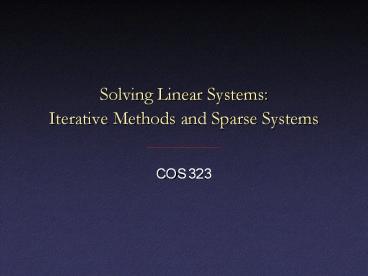Solving Linear Systems: Iterative Methods and Sparse Systems - PowerPoint PPT Presentation
Title:
Solving Linear Systems: Iterative Methods and Sparse Systems
Description:
Solving Linear Systems: Iterative Methods and ... at direct methods for. solving linear systems. Predictable number of steps ... large linear systems (n ... – PowerPoint PPT presentation
Number of Views:283
Avg rating:3.0/5.0
Title: Solving Linear Systems: Iterative Methods and Sparse Systems
1
Solving Linear SystemsIterative Methods and
Sparse Systems
- COS 323
2
Direct vs. Iterative Methods
- So far, have looked at direct methods forsolving
linear systems - Predictable number of steps
- No answer until the very end
- Alternative iterative methods
- Start with approximate answer
- Each iteration improves accuracy
- Stop once estimated error below tolerance
3
Benefits of Iterative Algorithms
- Some iterative algorithms designed for accuracy
- Direct methods subject to roundoff error
- Iterate to reduce error to O(? )
- Some algorithms produce answer faster
- Most important class sparse matrix solvers
- Speed depends on of nonzero elements,not total
of elements - Today iterative improvement of accuracy,solving
sparse systems (not necessarily iteratively)
4
Iterative Improvement
- Suppose youve solved (or think youve solved)
some system Axb - Can check answer by computing residual r
b Axcomputed - If r is small (compared to b), x is accurate
- What if its not?
5
Iterative Improvement
- Large residual caused by error in x e
xcorrect xcomputed - If we knew the error, could try to improve x
xcorrect xcomputed e - Solve for error Axcomputed A(xcorrect e)
b r Axcorrect Ae b r Ae r
6
Iterative Improvement
- So, compute residual, solve for e,and apply
correction to estimate of x - If original system solved using LU,this is
relatively fast (relative to O(n3), that is) - O(n2) matrix/vector multiplication O(n) vector
subtraction to solve for r - O(n2) forward/backsubstitution to solve for e
- O(n) vector addition to correct estimate of x
7
Sparse Systems
- Many applications require solution oflarge
linear systems (n thousands to millions) - Local constraints or interactions most entries
are 0 - Wasteful to store all n2 entries
- Difficult or impossible to use O(n3) algorithms
- Goal solve system with
- Storage proportional to of nonzero elements
- Running time ltlt n3
8
Special Case Band Diagonal
- Last time tridiagonal (or band diagonal) systems
- Storage O(n) only relevant diagonals
- Time O(n) Gauss-Jordan with bookkeeping
9
Cyclic Tridiagonal
- Interesting extension cyclic tridiagonal
- Could derive yet another special case
algorithm,but theres a better way
10
Updating Inverse
- Suppose we have some fast way of finding A-1for
some matrix A - Now A changes in a special way
A A uvTfor some n?1 vectors u and v - Goal find a fast way of computing (A)-1
- Eventually, a fast way of solving (A) x b
11
Sherman-Morrison Formula
12
Sherman-Morrison Formula
13
Sherman-Morrison Formula
14
Applying Sherman-Morrison
- Lets considercyclic tridiagonal again
- Take
15
Applying Sherman-Morrison
- Solve Ayb, Azu using special fast algorithm
- Applying Sherman-Morrison takesa couple of dot
products - Total O(n) time
- Generalization for several corrections Woodbury
16
More General Sparse Matrices
- More generally, we can represent sparse matrices
by noting which elements are nonzero - Critical for Ax and ATx to be efficientproportio
nal to of nonzero elements - Well see an algorithm for solving Axbusing
only these two operations!
17
Compressed Sparse Row Format
- Three arrays
- Values actual numbers in the matrix
- Cols column of corresponding entry in values
- Rows index of first entry in each row
- Example (zero-based)
values 3 2 3 2 5 1 2 3 cols 1 2 3 0 3 1 2
3 rows 0 3 5 5 8
18
Compressed Sparse Row Format
- Multiplying Axfor (i 0 i lt n i)
outi 0 for (j rowsi j lt rowsi1
j) outi valuesj x colsj
values 3 2 3 2 5 1 2 3 cols 1 2 3 0 3 1 2
3 rows 0 3 5 5 8
19
Solving Sparse Systems
- Transform problem to a function
minimization! Solve Axb ? Minimize f(x)
xTAx 2bTx - To motivate this, consider 1D f(x) ax2
2bx df/dx 2ax 2b 0 ax b
20
Solving Sparse Systems
- Preferred method conjugate gradients
- Recall plain gradient descent has a problem
21
Solving Sparse Systems
- thats solved by conjugate gradients
- Walk along direction
- Polak and Ribiere formula
22
Solving Sparse Systems
- Easiest to think about A symmetric
- First ingredient need to evaluate gradient
- As advertised, this only involves A multipliedby
a vector
23
Solving Sparse Systems
- Second ingredient given point xi, direction
di,minimize function in that direction
24
Solving Sparse Systems
- So, each iteration just requires a fewsparse
matrix vector multiplies(plus some dot
products, etc.) - If matrix is n?n and has m nonzero entries,each
iteration is O(max(m,n)) - Conjugate gradients may need n iterations
forperfect convergence, but often get decent
answer well before then































